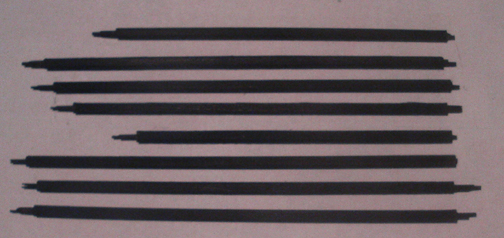Copyright © 2007 - 2025, Coachworks For contact data Click Here.

Copyright © 2007 - 2025
Copyright © 2007 - 2025,
Coachworks For contact data
Click Here.

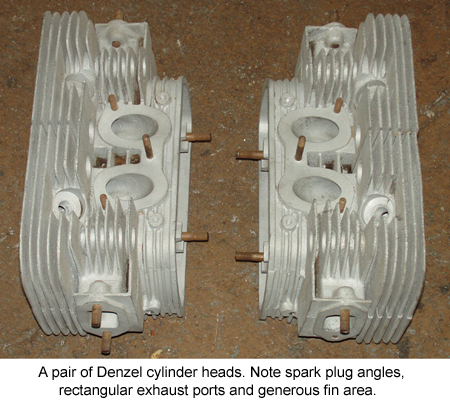 Photographs
tell the story...
Photographs
tell the story... ...almost! The photos can't tell some of the back story, so we'll tell you just a little more.
We were lucky and had several pairs of heads to choose from and decided to use the worst pair.
"Worst Pair!"
Yes. If something were to go wrong while racing, why put your best parts at risk? Even more luckily, all of the heads we had to choose from were great!
These first images are each of the several pair rather randomly as we just wanted to show Denzel head features. And, actually, they were pairs. The ones at right had no copper rings but you can note the broken off exhaust stud in one port - we didn't use this pair. The head below has copper rings for iron cylinders and we didn't use that pair either.
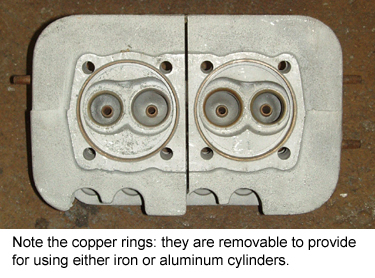
The pair identifiable with the caption starting "DON'T FLYCUT THESE HEADS"
has bronze valve seats and we didn't use that pair, either!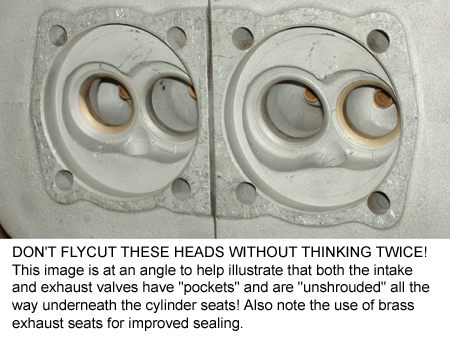
There were a great many steps involved in getting these mounted on the vehicle and we don't have photographs of all of it, unfortunately.
We started with a pair that already had steel exhaust seats installed. (One of them is in the image with rockers mounted but without valves.) This particular pair of heads had the bad luck that in its past something had floated around loose inside one combustion chamber and it was beat up. In one of the steps cited below we cured that problem by machining the surface to match the crown of our high-compression (high-domed) pistons. Thus, a sow's ear was turned into a silk purse!
Just to bang this out so we can go back to work on the car, we performed the following steps:

Here's a close-up of the valve assembly. If you look closely, you'll see the dual spring setup. What a pain! And... An image with the head mounted to the engine, rockers fitted and pushrods installed. This was during the pushrod length check - we'll have to make new pushrods!


In the shot below left, you can see the spacing of the rockers, and if you look closely, below right, you can see the spacers we made to position the rockers properly. You can also see how the equal length head studs work on a Denzel - at least when installed. The usual Denzel setup has studs that stick through with standard nuts on top of spacers that look very much like these head bolts, and they do provide an identical-height-grip even without identical length studs. The setup we are using, however, has true equal length head studs to help guarantee no loss of cylinder to head sealing and reduce the risk of warpage under heavy load, heavy heat conditions.

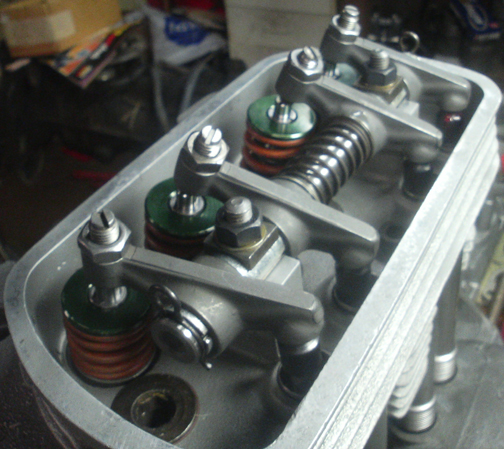
In this shot, look very closely and you can see the dual springs, the spring seat and you get a nice close-up of half of the valve keepers that we actually made just for this engine. The whole setup here is our engineering with the exception of the valves - straight Denzel copies made of modern materials - and the inner valve springs - they are stock Denzel. A few parts, like the outer springs and green retainers, we got from modern applications as off the shelf parts for something else.

Now, here's some shots of the rest of the equipment:
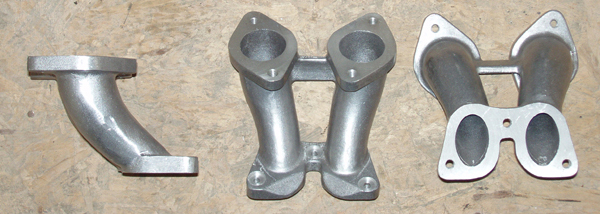
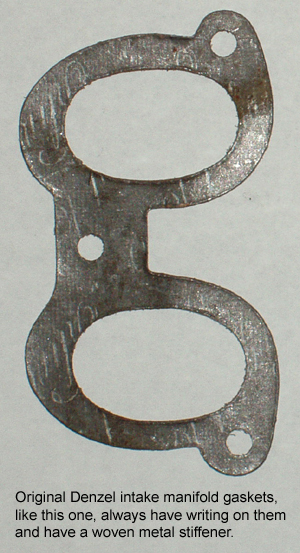
Here, we've hand fitted a gasket to the bottom of the intake manifold. Note that the gasket is precisely made; after fitting to the manifold, the gasket is then fitted to the head. Each gasket is then position specific!

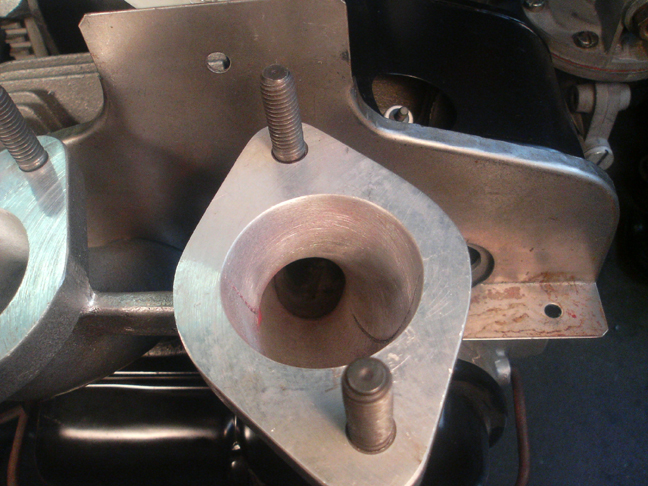 One
very critical factor to the efficiency of an engine is how restrictive the intake
system is - the less restriction, the more efficient. The stock 36hp intake
manifold is a designed-in rev-limiter! It has at least four curves that the
air has to go through to reach a cylinder. Contrast that with the Denzel intake
manifold - simplicity itself! Here are two images - it's hard to imagine a more
efficient intake manifold! NOTE: The color transition (or, light to dark, if
you will) is the transition from manifold to head. As you can see, it's a virtually
perfect mating!
One
very critical factor to the efficiency of an engine is how restrictive the intake
system is - the less restriction, the more efficient. The stock 36hp intake
manifold is a designed-in rev-limiter! It has at least four curves that the
air has to go through to reach a cylinder. Contrast that with the Denzel intake
manifold - simplicity itself! Here are two images - it's hard to imagine a more
efficient intake manifold! NOTE: The color transition (or, light to dark, if
you will) is the transition from manifold to head. As you can see, it's a virtually
perfect mating!
We've left these images rather large so you can see the detail....
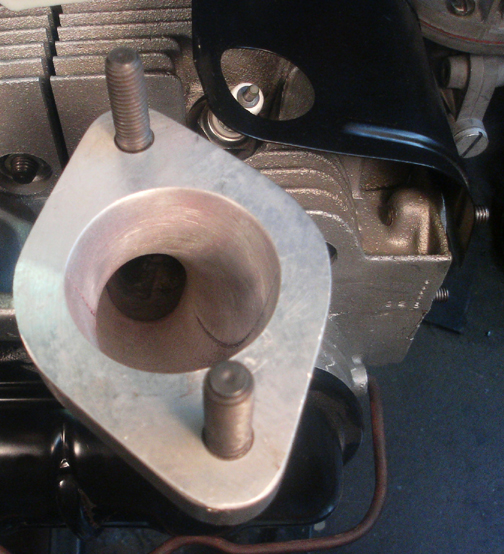
Something of vital interest but often overlooked are the pushrods. Here are some images that show the detail. At top is a late Denzel pushrod. Below is an image of two tips, the upper, with tube, is the late-type stock Denzel, and the lone piece is a tip we made to server the same purpose. Note the heavy undercutting of the tip - this is required for high-lift camshaft applications. Yes, we could have made a more precision tip, but we were running out of time and made this one from an available donor using a lathe with grinding stone, "by hand." (Note that someone has gone to great expense to reproduce the Denzel pushrod tip, however, unfortunately, they did not realize that the high-lift cams require the under-cut, and so their tips will require this same modification for high-lift camshaft applications!)

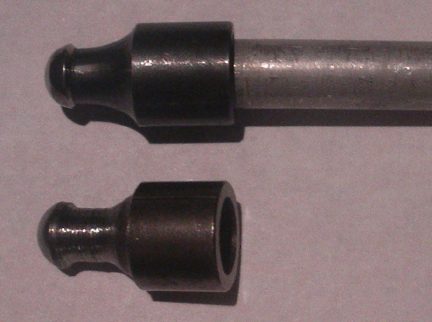
These black things are out-of-focus wooden dowels that Denzel put inside the pushrods - and which we removed! The purpose of these was to keep the delay time for oil pressure to build to a minimum - by taking up volume inside the pushrod, which moves oil up to the valve rocker shafts, and from there, the valve stems. When in service, however, these wooden pieces break apart (note how they're all different lengths), and clog the tips of the pushrods, thereby ensuring that _no_ oil gets to the heads! You have to take the pushrods apart to get these out! And, they're a press fit. Note that both VW and Porsche did the same thing, so it wasn't just Denzel being stupid - they all were rather daft on this one! (The camera just refused to focus on these, sorry!)
